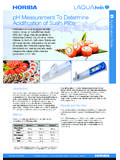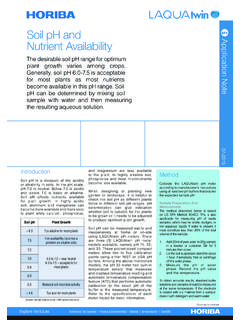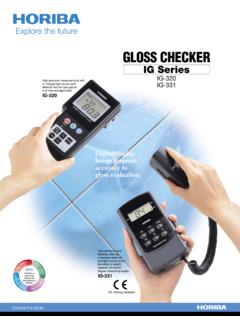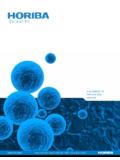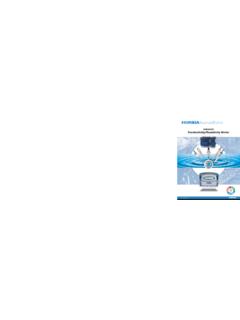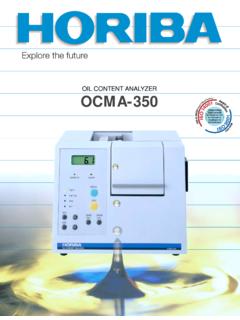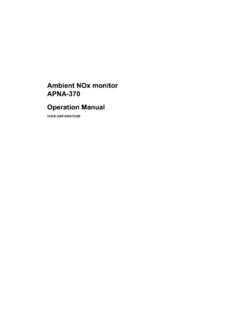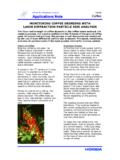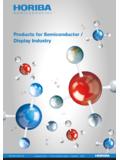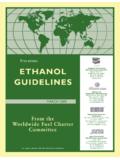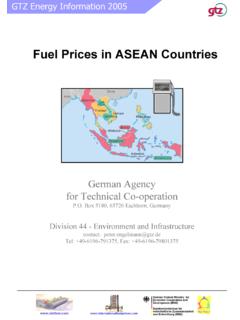Transcription of F A Measurement Systems for Diesel Exhaust Gas …
1 12 FEATURE ARTICLEM easurement Systems for Diesel Exhaust Gas and Future TrendsAbstractDiesel Exhaust emission Measurement Systems have undergone successive improvement to keep pace withimprovements of Diesel engines and rein forcements of the Exhaust emission regulations. It is likely that futureemission regulations will require emissions levels that are close to zero. For this reason, the achievement of a highlevel of precision in the Measurement of gaseous and particulate emissions is a critical issue. In addition, dieselexhaust Measurement has come to play an important role in the improvement of increasingly complex Diesel enginesand in the development of Exhaust after-treatment Systems for Diesel Exhaust Gasand Future TrendsIchiro AsanoFEATUREARTICLED irect-insertion NOx analyzerMicro-tunnelDe-NOx catalystOxidation catalystDPFFlow meteEngine Exhaust gas analyzer Soft ionization mass spectrometerFTIR-type engine Exhaust gas analyzer Continuous PM analyzerAutomatic engine Measurement systemChassis simulation system13 Technical
2 ReportsIntroductionDiesel engines are very durable and economical, andfor this reason they are widely used as motors for largevehicles, construction and agricultural machines, powergenerators, and ships. There is also hope that dieselengines can play a role in reducing carbon dioxide (CO2)emissions, which are a cause of global warming in recentyears. At the same time, there is a strong need to reducethe emission of nitrogen oxides (NOx) and particulatematter (PM) from Diesel Systems for Diesel engine emissions haveundergone successive improvement as emissionsregulations have grown stronger.
3 However, theregulations have recently become extremely demanding,and thus there is a strong need for even higher sensitivityand precision in emissions Measurement Systems . In thispaper I would like to discuss recent emissionsregulations, the current state of emissions measurementsystems, and future in Emissions RegulationsCompared to gasoline engines, Diesel engines are cleanand green, with fewer carbon monoxide (CO) andhydrocarbon (HC) emissions. However, no pollutionprevention technologies have appeared that have madethe dramatic reductions in Diesel emissions in the sameway as three-way catalysts have reduced emissions forgasoline engines, and thus Diesel emissions have beenreduced in stages.
4 However, the rate of attainment ofenvironmental standards for atmospheric nitrogendioxide (NO2) and suspended particulate matter (SPM) islow, particularly in major urban areas, and thus there isnow a strong need for a substantial reduction of thesepollutants from Diesel Regulatory Limits on EmissionsIn its third report on Future Measures for AutomobileEmissions Reductions, the Central Council forEnvironment, an advisory body of EnvironmentalAgency of Japan suggested attainment of the target limits(short-term targets) shown in Table 1.
5 Passenger carsand light vehicles are to attain the limits by the end of2002, mid-weight and heavy vehicles 12 tons and underare to attain the limits by the end of 2003, and heavyvehicles over 12 tons are to attain the limits by the endof 2004. The council also suggested the establishment ofnew long-term targets whereby the limits are to bereduced by half by about the year 20071).1 Europe is also studying similar emissions targets, whichare shown in Tables 2 and testing mode is different, and thus a simplecomparison is not possible, but Japan has establishedstricter targets for NOx, while Europe has establishedstricter targets for 1 Target Emissions Limits for Diesel Vehicles2 Vehicle typejNOxHCCOPMM easurementmethodPassenger tonsPassenger tons10-15 modeLight (g/km)to tonsMid-weight tons to tonsHeavy modefrom tons(g/kWh)
6 Table 2 Proposed EU Emissions Limits for DieselPassenger CarsTable 3 Proposed EU Emissions Limits for DieselHeavy-Duty VehiclesCOHC+NOxNOxPMEffective DateStep DateEURO IIIESC IVESC Emissions Testing MethodsThe Environmental Protection Agency (EPA)requires transient testing for heavy-duty truck and busengines however; until now, Japan and Europe haverequired only steady-state testing for heavy-duty engines;however, EURO III regulations in Europe will introducea transient test cycle (European Transient Cycle ETC )to be added to the steady-state test cycle (EuropeanSteady-state Cycle ESC ).
7 In addition, with respect to the new long-term targets,the report of the Central Council for Environment statesthat, The introduction of testing methods for transientrunning ( transient mode ) must be studied. Thus it islikely than transient testing will also be introduced inJapan when the new long-term regulations go into ARTICLEM easurement Systems for Diesel Exhaust Gas and Future Trends<Direct Measurement >In steady-state testing of heavy-duty engines, theexhaust gas from the engine is directly collected withoutdilution and the concentrations of components such asCO are mass emission of the pollutants are obtained duringthe test from the quantity of Exhaust gas flow, which isobtained from the air intake flow and fuel flow.
8 And theaverage concentrations of Exhaust gas direct Measurement does not dilute the exhaustgas, this method is better than dilution Measurement formeasuring low-concentration Exhaust , transient testing requires Measurement ofexhaust gas flow, which can change suddenly, and thusdirect Measurement is currently only used for steady-statetesting.<Dilution Measurement >In transient testing, a Constant Volume Sampling (CVS) system is used to obtain the mass emission of Exhaust gascomponents. A CVS system dilutes the entire Exhaust gaswith clean air to produce a constant flow.
9 A fixedproportion of the entire diluted Exhaust gas is collected ina sample bag to obtain a diluted Exhaust gas that isrepresentative of the average concentration while theengine runs. The diluted Exhaust gas can also measuredcontinuously to obtain the average concentration duringrunning. Mass emission of Exhaust gas components areobtained from the entire diluted Exhaust gas flow and theaverage concentrations of the pollutant in the diluted shows an example of the configuration of a Example of CVS system ConfigurationThe use of a CVS system is an excellent method forobtaining the mass emissioin of components of exhaustgas in transient testing, and this method has been in wideuse since the early 1970s.
10 However, as regulations havegrown stronger, the concentration of diluted Exhaust gashas fallen to the same level as that found in dilution air,and Measurement precision cannot be maintained, makingnew improvements necessary. Furthermore, when testingemissions from heavy-duty engines which have largedisplacement and is run at close to the rated speed, it isnecessary to use a very large CVS system that can dilutea large amount of Exhaust gas.<Particulate Matter Measurement >To measure particulate matter (PM) emitted from a dieselengine, the Exhaust gas from the engine is diluted andcooled to 52 C (or less) in a dilution tunnel in which cleanair flows.
